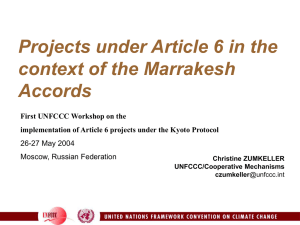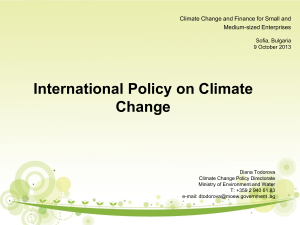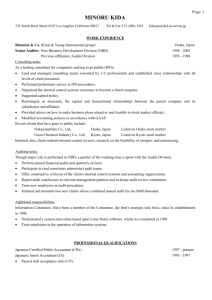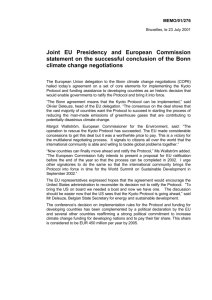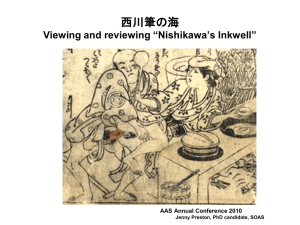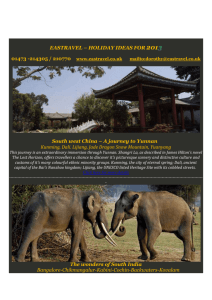Lesson 6 - Kyoto Protocol Deep Dive - UNAGB-MUN
advertisement
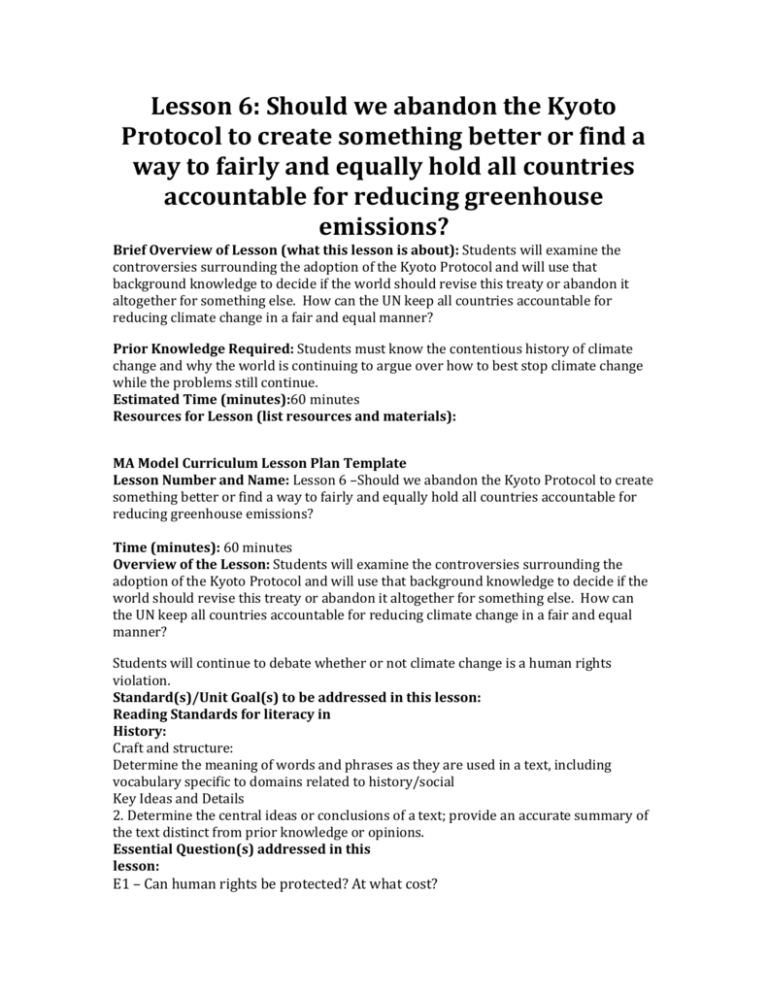
Lesson 6: Should we abandon the Kyoto Protocol to create something better or find a way to fairly and equally hold all countries accountable for reducing greenhouse emissions? Brief Overview of Lesson (what this lesson is about): Students will examine the controversies surrounding the adoption of the Kyoto Protocol and will use that background knowledge to decide if the world should revise this treaty or abandon it altogether for something else. How can the UN keep all countries accountable for reducing climate change in a fair and equal manner? Prior Knowledge Required: Students must know the contentious history of climate change and why the world is continuing to argue over how to best stop climate change while the problems still continue. Estimated Time (minutes):60 minutes Resources for Lesson (list resources and materials): MA Model Curriculum Lesson Plan Template Lesson Number and Name: Lesson 6 –Should we abandon the Kyoto Protocol to create something better or find a way to fairly and equally hold all countries accountable for reducing greenhouse emissions? Time (minutes): 60 minutes Overview of the Lesson: Students will examine the controversies surrounding the adoption of the Kyoto Protocol and will use that background knowledge to decide if the world should revise this treaty or abandon it altogether for something else. How can the UN keep all countries accountable for reducing climate change in a fair and equal manner? Students will continue to debate whether or not climate change is a human rights violation. Standard(s)/Unit Goal(s) to be addressed in this lesson: Reading Standards for literacy in History: Craft and structure: Determine the meaning of words and phrases as they are used in a text, including vocabulary specific to domains related to history/social Key Ideas and Details 2. Determine the central ideas or conclusions of a text; provide an accurate summary of the text distinct from prior knowledge or opinions. Essential Question(s) addressed in this lesson: E1 – Can human rights be protected? At what cost? E4 - What is it the responsibility of your generation to ensure the survival of future generations? E6 - How can the UN keep all countries accountable for reducing climate change in a fair and equal manner? Objectives Students will know and be able to… · Identify which countries have adopted the Kyoto protocol and why other countries have not · Analyze the impact of the Kyoto Protocol on politics and economics in underdeveloped and developing nations · Answers to the critical thinking questions · “Frame, Focus, and Follow-Up” on Kyoto protocol videos from several points of view · Response to Kyoto protocol prompt · Response to essential question: What is the responsibility of your generation to ensure the survival of future generations? · Identify the controversy of the Kyoto Protocol · Analyze the various positions of stakeholder nations · Debate the merits and flaws of the Kyoto Protocol to determine its viability as a force for climate change Language Objectives · Students will know and be able to articulate the main ideas and details of an article using key vocabulary Targeted Academic Language Protocol – Frayer Model What students should know and be able to do before starting this lesson Students should know what is meant by “politics” and “economics.” Anticipated Student Pre-conceptions/Misconceptions Instructional Materials/Resources/Tools http://www.nytimes.com/2014/09/25/opinion/gail-collins-the-politics-of-climatechange.html?_r=0 http://www.lse.ac.uk/GranthamInstitute/event/the-politics-of-climate-change-2014what-cause-for-hope/ http://www.pbs.org/wgbh/pages/frontline/environment/climate-of-doubt/timelinethe-politics-of-climate-change/ Instructional Tips/Strategies/Suggestions for Teacher Plotting opinion on a continuum Frayer Model on Protocol Content Response Notes on The Politics of Climate Change Think Write Pair Share Revise Frame Focus Follow-up Assessment Content response notes Kyoto Protocol writing prompt Lesson Details (including but not limited to:) Connect to the Previous lesson: Students discuss EQ - What is it the responsibility of your generation to ensure the survival of future generations? – use a continuum line to chart responses. Cover up this continuum once students have finished putting themselves on this, as they will be doing this again at the end of class and will need to compare their responses from the beginning and end of the class. Opener: Students make a prediction – which countries have adopted the Kyoto Protocol? Activate: Students analyze a graphic/chart/map of which countries have adopted the Kyoto Treaty. They should check over their list from the Do Now - which did they guess correctly? any surprises? http://en.wikipedia.org/wiki/Kyoto_Protocol#mediaviewer/File:Kyoto_Protocol_partie s.svg http://kids.britannica.com/comptons/art-113249? Discuss: Why do you think some countries would not adopt an environmental treaty? Conceptual Vocabulary: controversy, bias, spectrum *Using Vocabulary.com to allow students to look up a student-friendly definition, listen to pronunciation, and look at the word in real-world context will help students build meaning in order to motivate students and quickly move through the 7 Step Method. *To get student buy-in using the 7 Step Method, it is important for them to understand the importance of using and pronouncing key words correctly. When they participate in the Model UN Simulation student performance is based on a polished presentation. Misuse or mispronunciation of a crucial vocabulary term will detract from credibility when trying to make convincing arguments. Content/Response notes: Students will read an article about the impact of the Kyoto Protocol on politics and economics on developing and underdeveloped nations and take notes using Content /Response notes *link to template and directions here* http://www.hks.harvard.edu/fs/jfrankel/ImpactOfRevisedKyotoProtocol.pdf (advanced) http://elibrary.worldbank.org/doi/abs/10.1596/1813-9450-2019 http://www.theguardian.com/environment/2011/mar/11/kyoto-protocol http://www.npr.org/templates/story/story.php?storyId=4504298 o Students should identify main ideas and details (right-hand side) o While students are reading and taking notes they should be making comments, asking questions, inferring, and predicting (left hand side) o Students will synthesize main ideas and details to summarize the issue of climate change as outlined by the UN. § For struggling learners, scaffold as necessary. Possibly have students preview the text before reading to increase comprehension. As students find main ideas and details have them reach consensus with a partner. o In pairs students should share comments, answer one another’s questions and make connections § Share responses as a class o Advanced Learners can use the links within the document to deepen their understanding of the topic. Building Comprehension: Students will respond to several guided reading questions at the end of their reading Checks for Understanding: How has the Kyoto Protocol helped and hurt developing countries around the world? Frame Focus Follow-up: show videos on several points of view on the Kyoto Treaty · Frame: The United States has not adopted the Kyoto Protocol, angering many other countries around the world. · Focus: After each video, write down at least two reasons that were given about why the US should or should not adopt the Kyoto Protocol · Follow-up: How can the UN keep all countries accountable for reducing climate change in a fair and equal manner? Discuss: Kyoto Protocol writing prompt: in your opinion, should the United States adopt the Kyoto Protocol? Explain your reasons why or why not, using evidence from your notes Summarizing activity: Using their responses students should then re-visit the Essential Question: E4 - What is it the responsibility of your generation to ensure the survival of future generations? Teacher has students plot themselves on the continuum again in response to the EQ above. They then compare how they fell on the continuum at the beginning and end of class. Students should explain to partners why they think their opinions changed or stayed the same.
